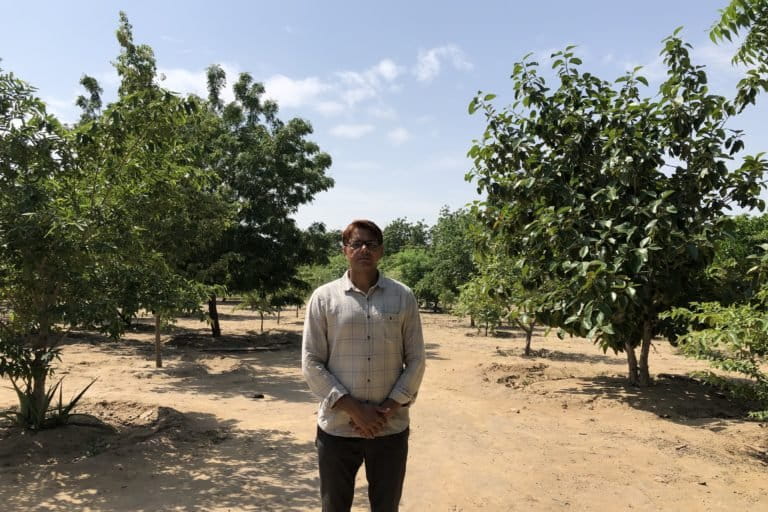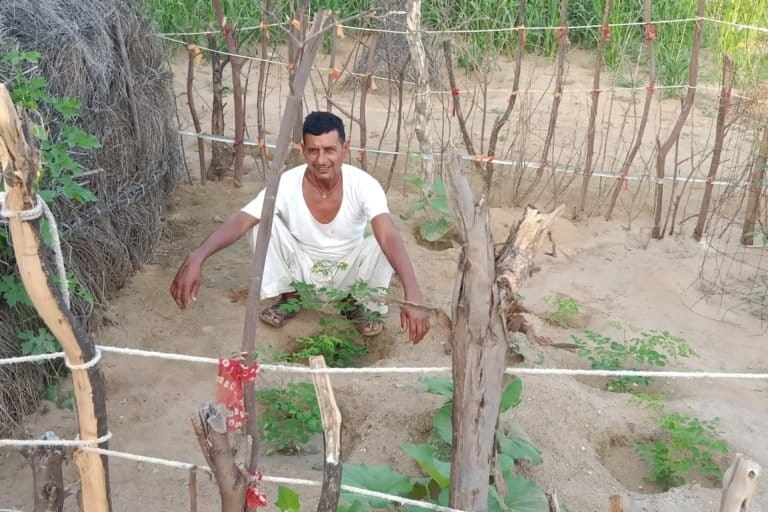- Desertification, groundwater salinity and soil nutrient loss are common ecology risks in the desert region of western Rajasthan and this worsens as the desert grows every year.
- Afforestation, which can help prevent ongoing desertification, is a challenge here. Shyam Sunder Jyani is leading efforts to restore the ecosystem with primarily indigenous species in an attempt to reverse the harmful impact of invasive species and human activity.
- Jyani undertakes plantations in educational institutions or on family land and public places. He recently won the United Nations Convention to Combat Desertification (UNCCD)’s 2021 Land for Life Award.
Shyam Sunder Jyani, who hails from the hot and sandy Thar desert region of India, greets you with an unexpected ode to greenery – “हरित प्रणाम”, he says, a Hindi term for “Green Greetings”. Jyani has been leading greening efforts in Rajasthan for the past 18 years and has mobilised thousands to participate in the protection of this north-west Indian landscape.
Jyani comes from a farming family in a small village in Ganganagar, 20 kilometers from the India-Pakistan border, deep into the Thar desert in Rajasthan. Now an associate professor, he has always been aware of the challenges a desert ecology presents. Rajasthan is the largest and most arid state in India. Jyani has been working towards restoring and preserving the desert ecosystem and combating desertification through a holistic effort of plantation and sustainable living.
He has been leading these efforts in Rajasthan since the year 2003 and has planted more than 2.5 million trees to date, most of it funded himself, while plantation help comes from thousands of villagers who have joined his grassroots campaigns to green Rajasthan. The survival rate of these plants is more than 95 percent, says Jyani. A resident of Bikaner, where he is an associate professor of sociology in Government Dungar College, most of Jyani’s work has been focused in the western part of Rajasthan where the desert landscape is the most dominant.
Retired Deputy Conservator of Forest in Bikaner, Kaushal Saxena, who has followed Jyani’s work for several years, says, “He planted indigenous species all over Rajasthan, wherever he could – that involves wastelands, forest lands, grazing grounds, and even unused government properties.”

Jyani has introduced two models to encourage people to join him in planting: Institutional Forest, which executes sustainable forest management in educational institutions and Familial Forestry, where trees are planted either on the family land or in public places and adopted as ‘green members’ of the family. These efforts are ongoing in more than 10,000 villages of northwestern Rajasthan.
The concept of Familial Forestry also won Jyani the United Nations Convention to Combat Desertification (UNCCD) Land for Life award this year. As he states, “The journey of desertland Rajasthan towards a lush green Rajasthan has been a dream for me, and Familial Forestry is my dedicated endeavor in this direction.”
Undoing the damage of invasive plant species
In India, a study notes that the dry wastelands of Thar occupy most of Rajasthan (60%); the remaining portions expand into the neighbouring Haryana and Gujarat states in the north and south, respectively.
Desertification, groundwater salinity and soil nutrient loss are the common ecology risks in the desert regions of western Rajasthan and this worsens as the desert grows every year, threatening the ecology of the region, notes a recent study, Environmental Sustainability of the Thar Desert, West India. This ongoing desert expansion represents an adverse factor with respect to the economic development, ecological integrity, and environmental sustainability of western Rajasthan.
The degradation of the environment in Rajasthan has resulted in destruction of the ecological system and loss of biodiversity. As Jyani explains, “Human activities like applying new agriculture techniques, mining, overgrazing by animals, introducing foreign flora and fauna, inserting tube wells, overexploitation of the IGNP Canal and human settlements in the desert have become a hazard to the Thar desert’s natural ecosystem. The Thar is the most densely populated desert on earth. Of course, these developments have severe consequences.”
The propagation of exotic, invasive plant species like Acacia tortilis and Prosopis juliflora that were planted by the Britishers for sourcing wood and later by the forest department of Rajasthan as forest cover, have had a detrimental effect on the environment. These species could survive on little water, were good for nitrogen fixation and stabilised the sand dunes in the desert, so were easy to plant in a desert where forestation usually is an arduous task.
But these species are not compatible with the wildlife of the desert and ruin the microclimate of the area they are planted in. “Alien, invasive species are alright to grow in small spaces like acacia or eucalyptus have been planted along the IGNP canal. But when these species are propagated to large spaces, they cause allelochemical harm to the indigenous species,” notes Anil Dular a faculty at the Department of Environmental Science at the Maharaja Ganga Singh University (MGSU), Bikaner.

But Saxena elaborates, “When the government started planting foreign species like Acacia tortilis or Prosopis juliflora, many senior officials protested. But I’ve seen the immense market these trees have. These are fuel woods, an industry very much prevalent in Rajasthan today. These trees fill that demand. We have earned crores in revenue from these plantations.”
Taking cognizance of this issue, Jyani has focused on planting indigenous and fruit bearing species like khejri (Prosopis cineraria), rohida (Tecomella undulata), neem (Azadirachta indica), ber (Ziziphus mauritiana), amla (Phyllanthus emblica), etc. in his bid to reverse the harm done by invasive plants and green Rajasthan. He gets the water and soil profile tested in every area and accordingly plants species beneficial to that place. As Dular emphasises, “In the concept of 5Fs – providing food, fodder, fibre, fruit and furniture – we have found that indigenous species provide the most. It may be 3 or 4 (of these five), but they provide. That is the main difference between exotic and indigenous species of Thar.”

Jyani has never officially collaborated with the forest department in Rajasthan, but the officials familiar with his work commend his devotion and efforts towards the environment. In their own capacity, officials from different districts have often helped him in procuring plants that he then freely distributes in the villages across Rajasthan.
Mahendra Singh, the Deputy Conservator of Forest, Administration at Office of the Regional Chief Conservator of Forests, Bikaner, expresses how he has admired Jyani’s efforts and oftentimes facilitated the procurement of certain plants in the Bikaner division for him, which Jyani then freely distributed.
However, mere plantation in deserts for complete forestation of the landscape is not sustainable, say experts. Any comprehensive model in the desert agro-ecology space needs to be regenerative in nature. Simply planting trees is not a sustainable solution but an aspect of the bigger problem that doesn’t solve it in its entirety, explains Aakriti Srivastava of Desert Resource Centre, adding, “It is a very welcome effort. However, there are more diversified interventions required for a sustainable outcome. You need more rural youth to participate. It’s not an “either/or” situation. Also, when you are talking about millions of acres of land then the problem needs to be approached with a multilateral approach with the ownership of both individuals and institutions. If it is not taken up by people in this spirit then I am afraid, it could become just another plantation drive.”
The ‘green’ family member
Jyani directly involves families in plantation and care of their own home forests. “It is an effective alternative to forestation, through which trees planted are seen as members of the family to be cared for,” says Jyani. The trees are planted either on family land or in public places in these villages. As Jyani explains, what has been done to the desert land and ecosystem through human developments cannot be reversed. The alternative is informing and inspiring people to work towards a positive change in the environment. Plants and trees are usually seen with an economical perspective or a religious one – he explores both.
While inspiring villagers in Rajasthan to bring about change, Jyani applied a multifaceted approach: planting indigenous trees that would increase land fertility and planting fruit-bearing trees that would provide families with nutrition and have an overall aesthetic value.
He also started hosting free-of-cost plantation drives and motivated people to gift plants in their marriage, death and birth ceremonies. These plants were also offered as prasad in local religious festivals. All of these efforts have cultivated a bond between the villagers and plants. Jyani stays connected with the families through phone and social media.
Read more: ‘Green walls’ can help combat desertification, says IPCC report
Jyani’s efforts have reached Indian diaspora in the United Kingdom and Canada who have also undertaken this model on their own lands.
Vijay Pal Beniwal, a former student of Jyani states, “Professor Jyani’s devotion towards environment is amazing. Every Dungar college student or their relative for sure has a sahjan (drumstick) tree planted in their home under his guidance.” When Beniwal got married in 2019, he spent 40,000 rupees, originally meant for firecrackers, on gifting plant saplings to all the guests.

Mini forests in schools and colleges
The institutional forest model is something that Jyani developed when he first implemented it in his own workspace, the Government Dungar College in Bikaner where he has created a mini jungle with thousands of trees in 100 different varieties. Saxena, who himself is a Dungar College graduate and has often visited after the barren land was transformed, says, he found the temperature cooler inside the forest. In this approach, cluster plantations are done in a designated zone to create a ‘mini-jungle’.
Jyani has a network of school children, teachers and climate-concerned individuals in desert area districts like Bikaner, Jodhpur, Churu, Sri Ganganagar, Hanumangarh, etc. whom he works with to create a green zone in public schools. This model has currently been adopted by 170 rural schools in 170 villages across the state, says Jyani.
Kalu Jakhad, a primary school teacher in village Khodala, Bikaner has also established a forest block under this model. He planted around 100 saplings in 2018 that have now turned into trees. Even during summer vacations and pandemic lockdowns, he and his fellow teachers travel 30 kilometers every day to water and care for these plants.
Jyani believes that if the children learn these sustainable management techniques in school through the institutional forest model and at home through the Familial Forestry model, they will grow up with a sense of environmental conservation.
Read more: [Commentary] India holds great promise in this Decade on Ecosystem Restoration
Banner image: Shyam Sunder Jyani has been encouraging school children to take up plantation in their schools. Photo by Shyam Sunder Jyani.
